You’re driving down the road when you see a deer in headlights… But, what kind of deer is it? After all, there’s more to deer than just antlers.
Otherwise known as Cervidae, the deer family is pretty broad. In fact, there are 43 species of deer.
But with members ranging from whitetail, elk, reindeer, red deer, and every dear deer in-between, how are you supposed to tell the difference?
Let’s explore the fundamental differences between 10 of the types of deer you’re likely to either encounter or hear about.
- Whitetail Deer
- Blacktail Deer
- Coues Deer
- Mule Deer
- Red Deer
- Chital / Axis Deer
- Elk
- Reindeer
- Sika Deer
- Vampire Deer (Musk Deer)
1. Whitetail Deer
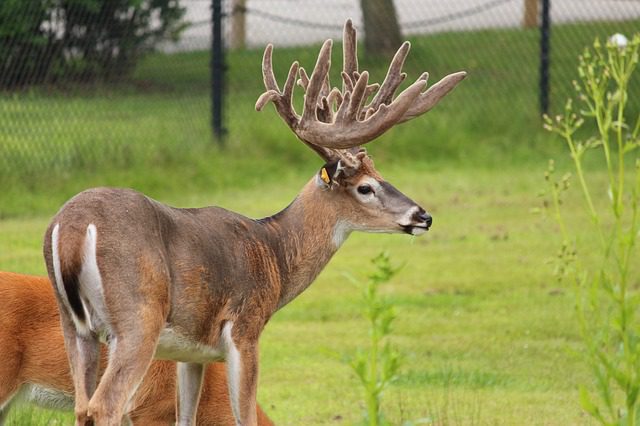
The whitetail is one of the most sought after deer by hunters in North America.
This medium-sized mammal is native to the Americas, weighing in at anywhere from under 100 lbs to over 300 lbs.
Doe (female deer) can weigh anywhere between under 100 lbs to 200 lbs.
White-tailed deer can sometimes be challenging to identify at first glance, as their coats change color seasonally. They can be found with reddish-brown coats under the summer sun, trading these in for more grayish-brown substitutes as winter closes in.
The white-tailed deer, usually referred to simply as the whitetail, earned its name thanks to the prominent white marking under its tail. (If a whitetail deer has piebaldism, it can lead to some unique and stunning markings.)
While the whitetail’s tail is primarily used to warn fellow deer when danger is near, this white marking also helps explorers and hunters distinguish the whitetail from other deer.
This particular deer is also unique in terms of body language. Whitetails are known to showcase various postures, including the “ear drop” to send other deer away, the “hard look” to show anger, the “antler threat” to display dominance, and the fighting stance to prepare for battle, so to speak.
During the breeding season, or “rut,” bucks (males) can often be found making violent antler contact, testing each other’s strength for the right to breed receptive does. This battle normally ends when one deer is too tired to continue but can also end in the death of one or both bucks.
Sometimes when fighting, bucks can get their antlers entangled with each other, unable to break apart. In these instances, bucks can even die if they cannot get separated.
Whitetail deer are a highly sought after game animal by rifle hunters as well as bowhunters.
2. Blacktail Deer
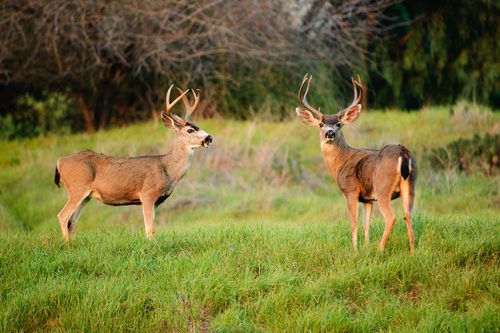
Blacktail deer have distinctive black tail with a white patch underneath.
Normally found across the hills of Central California and the mountainous region of Alaska, the Columbian black-tailed deer is a sub-species of the mule deer.
The blacktail is slightly smaller than most mule deer or his white-tailed cousin, though. Like white-tailed deer, blacktail also change their coat colors, from a reddish-brown in summer to a brownish-gray in winter.
Blacktail are normally easy to spot by their ears, which move independently. This particular deer’s broad tail is totally black or dark brown at the top, with a white patch underneath.
This would make him easy to confuse with the white-tail, were it not for his distinctive dark brown antlers with symmetrical branching and easily-identifiable stocky bodies with long, slender legs.
Black-tailed deer weigh in at about 130 pounds, but can reach closer to 200. While blacktail males have antlers, their female counterparts do not – and male fawns start growing antlers at about 6-8 months old.
Blacktail can normally be found in forested mountains on the pacific coast, where the climate is mild and cool with plenty of rainfall. Blacktail live off a diet of acorns, fungi, lichen, nuts, berries, and shrubs
-

N1 Outdoors® Stain The Vanes™ Bowhunting Tee
Price range: $24.99 through $30.99 Select options This product has multiple variants. The options may be chosen on the product page -
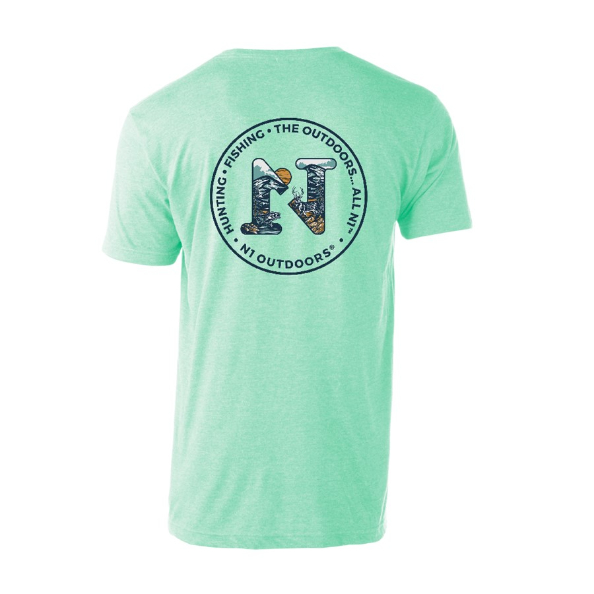
The “Outdoors All N1™” Hand Illustration Tee
Price range: $24.99 through $28.99 Select options This product has multiple variants. The options may be chosen on the product page -
Sale!
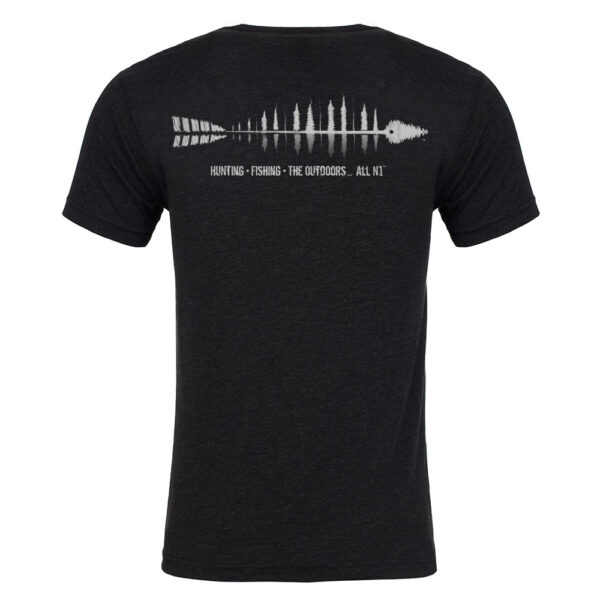
N1 Outdoors® Trifecta Fish Arrow Tee
Original price was: $22.99.$5.00Current price is: $5.00. Select options This product has multiple variants. The options may be chosen on the product page
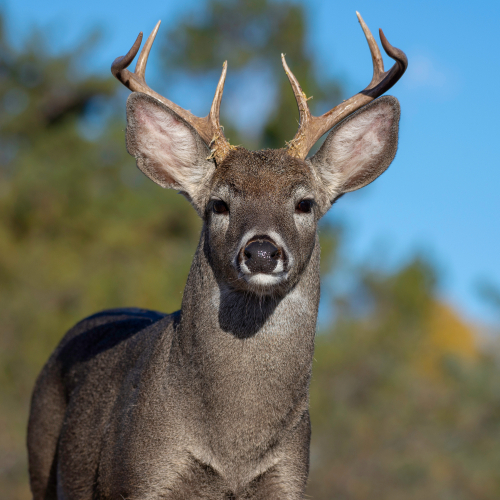
Coues deer bucks have main beams that curve forward.
3. Coues Deer
This specific kind of white-tailed deer is among the most commonly found across the South-Eastern mountains of Arizona, especially during the rainy summertime.
Coues can be found in woodlands where there is plenty of oak, chaparral, and pine.
Coues deer are known for their distinctive antlers. The coues’ mean beam curves forward, and more mature coues have 3-4 tines on each side.
When it comes to coat, the coues is normally grayish-brown with specks of “salt and pepper,” and white patches underneath. The coues’ most distinguishing trait is his long and broad tail, which is grayish-red-black on top and white underneath.
Coues deer are normally quite small, and fawns are known to stay close to their mothers for longer than other deer.
4. Mule Deer
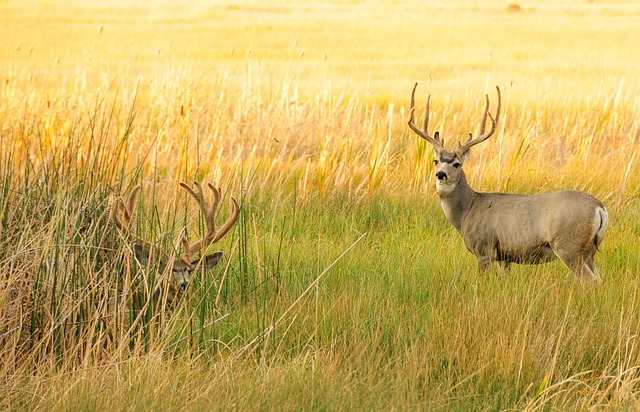
Mule deer bucks have distinctive white patches on the backs of their hips and males have forked antlers.
Mule deer are commonly spotted in deserts across North and South America, flaunting large ears that first granted them their name.
The mule deer’s tail appears to have been dipped in black ink, and his antlers are forked.
You’ll also find a distinctive white patch on either hind side, which easily differentiates the mule deer from any other deer in America. The mule deer sports a grayish-brown coat, making it easier for him to adapt to his unique climate in desert areas.
Mule deer, often referred to as muleys, normally range from about 3 feet tall at the shoulders to a towering 7 feet (including antlers), weighing up to 280 pounds.
In addition to the whitetail, the mule deer is also one of the types of deer sought after by hunters.
5. Red Deer
The Red deer (Cervus elaphus), Britain’s largest land mammal, can weigh anywhere from 90 kg to 190 kg (around 100 to 225 lbs). They stand up to 1.37 meters (4-1/2 ft) tall at the shoulder, and can normally be found in wooded lowland areas.
But, the part of this deer’s anatomy that sets it apart from other deer so distinctly, is its noticeably large head and wide-spaced brown eyes.
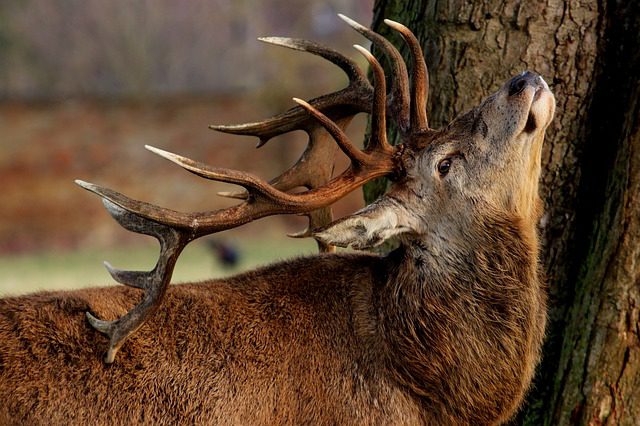
A male red deer is called a “stag.” The stag’s antlers are branched.
A male red deer is called a stag. His antlers are perhaps his most distinctive feature – highly branched with multiple points on each.
The Red Stag’s antler branches increase with age at an angle.
Another unmistakable trait of the Red Stag are its hoof prints, otherwise known as “slots.” These are often mistaken for sheep or goat’s marks.
Red Stags can actually be found all across the globe, boasting a strong presence on most continents.
Most naturally occurring populations of Red Stag span across the UK and into parts of Northern Africa and Southwest Asia, with Scotland and the Netherlands being known for their large populations.
Red Stag have historically been a prime species for transplantation, considering their size, beauty, and the large market for hunting Red Stag.
Due to this, there are now large populations of Red Stag in Argentina, Chile, Australia, and several other countries where they were transplanted and have since thrived.
Their breeding season, or “Rut” for red stag lasts from September through early October, in which Red Stag’s are known the become extremely competitive and sometimes aggressive.
6. Chital / Axis Deer
The Chital Deer, otherwise known as the axis deer, boasts unique characteristics that set it apart – one of which is the white spots that never go away. These speckled dots stay in place from youth through to adulthood, normally covering the entire body and spanning down the legs too. These spots make the axis deer one of the most easily recognized types of deer.
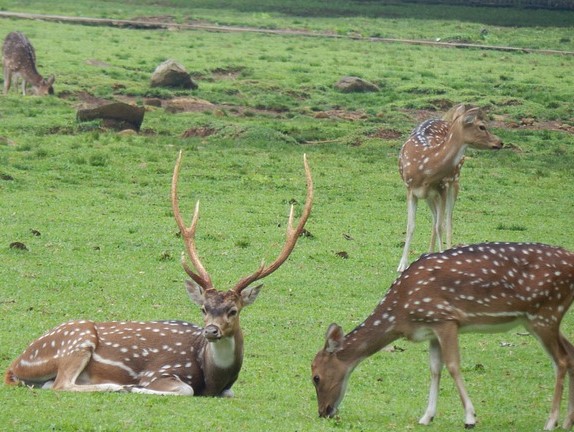
Axis deer have spots resembling those of a whitetail fawn, but they do not go away as they mature as the whitetail do.
The Chital Deer also has a rather long muzzle topped off with a dark black nose.
The axis deer normally weighs anywhere from 60 pounds to 170 pounds, depending on the region and habitat.
An interesting feature of male axis deer are their antlers, which normally have six points. However, more dominant bucks are found with more than this, making them significant trophies.
The axis deer were introduced in the United States in the 1930’s. The state of Texas has the highest population of axis deer in the U.S.
The axis deer is normally found living in secondary land areas, around glades where there is plenty to eat. The axis deer’s hoof shape prevents them from walking well on rugged terrain. So, they tend to avoid these types of areas.
The axis deer tend to be more social than other types of deer.
7. Elk
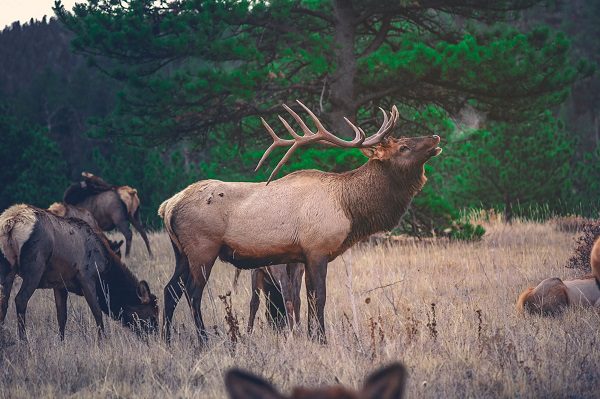
The elk was nearly killed off by early U.S. settlers, but now thrive, especially in the Western United States.
This member of the deer family is found primarily in the Western United States and Southern Canada.
The elk’s history is complex, with most being killed by Western U.S. settlers by the early 1900’s. The sole survivors were found mostly in the region just west of the Rocky Mountains.
Thankfully, reintroduction efforts were successful, and the elk can be found in many areas today – towering tall at 4-5 feet high at the shoulder. Some even reach up to 9 feet or higher, counting antler height.
You can spot an Elk from a distance, with a copper brown coat. This can change to light tan during the Fall and Winter months.
Elk are also easily noticeable by their rump patch, and short light-brown tail. Elk can be found feeding on all types of plants, mostly grass. Although, elk also enjoy twigs, forbs, fir, juniper, aspen, and chokeberry. They also love shrubs, particularly during the cold winter months.
Elk predators include cougars, wolves, coyotes, and bears, which often kill calves and sick adults.
8. Reindeer

Reindeer spend much of the deer grazing.
This Christmas “legend” is actually a real deer. The male reindeer is unique among the rest, easily identifiable mainly by its antlers.
Other distinctive characteristics include his broad hooves, wide muzzle, and extra-thick brown fur.
These majestic creatures are a medium-sized member of the deer family, found across forests, mountains, and arctic tundra in Canada, Alaska, Scandinavia, and Northern China.
Reindeer normally travel in massive herds and live in the wild for about a decade.
More domesticated reindeer are herded by Asian Artic and European peoples.
Reindeer are herbivores, and spend most of the day grazing. During the cold winter months, Reindeer can be found grazing on moss and lichens, leaves and herbs.
-
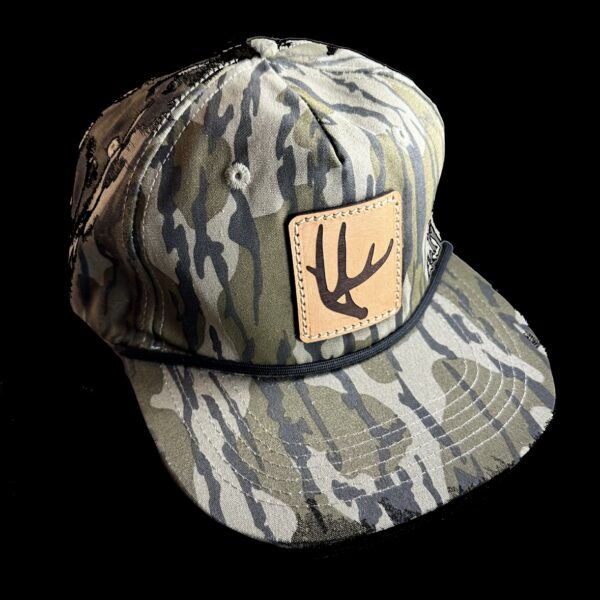
N1 Outdoors® Antler Leather Patch Camo Rope Hat
$29.99 Add to cart -

N1 Outdoors® Leather Patch Logo Retro Camo Trucker Hat
$29.99 Select options This product has multiple variants. The options may be chosen on the product page -
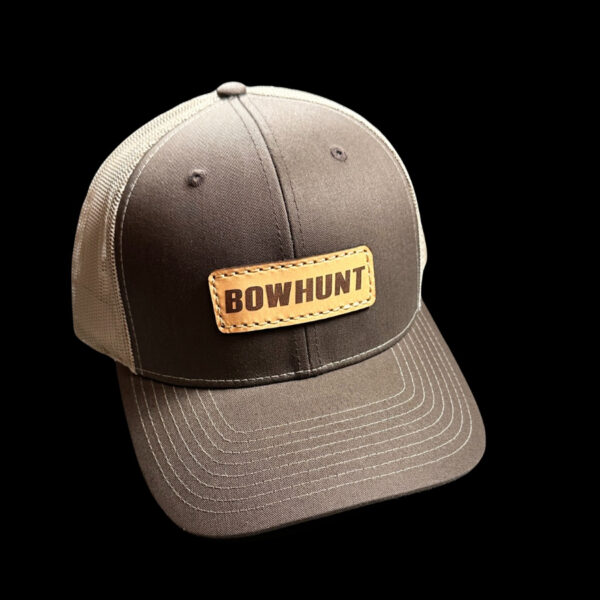
N1 Outdoors® “Bowhunt” Leather Patch Hat (Brown/Khaki)
$29.99 Select options This product has multiple variants. The options may be chosen on the product page
How To Tell The Difference Between a Reindeer And A “Regular Deer”
A common question is, what’s the difference between a deer and a reindeer?
When most ask this question, what they really mean is how are whitetail deer and reindeer different? So, let’s cover a few distinctive differences.
Reindeer vs. Whitetail Deer: Key Differences
While reindeer and whitetail deer do in fact share some similarities, they have distinct differences that set them apart. Here’s a few of the ways in which they differ:
1. Habitat and Range
- Reindeer: Also known as caribou in North America, reindeer are native to the Arctic and sub-Arctic regions. They are well adapted to cold climates and are commonly found in tundra and boreal forest habitats.
- Whitetail Deer: Whitetail deer are native to the Americas and have a wide range that spans from Canada to the northern regions of South America. They thrive in a variety of habitats including forests, grasslands, and even suburban areas.
2. Physical Characteristics
- Reindeer: Reindeer are larger and stockier than whitetail deer, and they have a dense coat that helps them survive in their colder habitats. They have broad, rounded hooves. Both males and female reindeer grow antlers, although those of males are typically larger.
- Whitetail Deer: Whitetail deer are generally smaller and leaner compared to reindeer. They have a lighter coat that varies in color from reddish-brown in summer to grayish-brown in winter. Only male whitetails grow antlers, which they shed and regrow each year.
3. Behavior and Social Structure
- Reindeer: Reindeer are known for their migratory behavior, often traveling long distances between their summer and winter ranges. They live in herds, which can vary in size from small groups to large aggregations of hundreds.
- Whitetail Deer: Whitetail deer are more solitary compared to reindeer, although they do form small groups, especially in winter. They are less migratory, with movements typically limited to their home range or territory. During the rut, male whitetails will have broken off from their “bachelor groups” and compete with other bucks for breeding rights.
4. Diet
- Reindeer: Reindeer are herbivores that feed on a diet of lichens, mosses, grasses, and shrubs. Their diet is well adapted to the cold, harsh conditions of the Arctic.
- Whitetail Deer: Whitetail deer have a more varied diet than reindeer that includes leaves, fruits, nuts, and vegetation. They are more flexible in their eating habits, adjusting their diet based on seasonal availability. For example, if they may feed primarily on acorns in early Fall and once that food source is gone, move on to other vegetation or food sources.
5. Adaptations
- Reindeer: Adapted to extreme cold, reindeer have specialized nasal passages to warm the air they breathe and thick fur for insulation.
- Whitetail Deer: Whitetail deer can adapt to a wider range of temperatures and environmental conditions. They have less tolerance for cold weather than reindeer, but are highly adaptable to various habitats.
9. Sika Deer
Sika deer, also know as Cervus nippon, are an elegant and fascinating species that hold a special place among deer enthusiasts. The Sika deer are native to East Asia and these deer have made their mark in various parts of the world due to introductions and escapes from captivity.
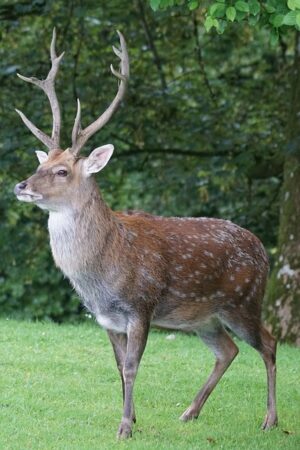
Renowned for their striking appearance and adaptable nature, Sika deer have become a significant part of many ecosystems, captivating the attention of hunters and wildlife enthusiasts alike.
The Sika deer’s unique appearance sets it apart from other deer. These medium-sized deer usually stand between 2.5 to 3.5 feet tall at the shoulder and weigh anywhere from 90 to 150 pounds.
Sika deer are recognized by their coat, which changes with the seasons. In the summer, their coat is a reddish-brown with white spots that blend seamlessly into their forested habitats. As winter approaches, their fur darkens to a grayish-brown, offering better camouflage against the snow.
One distinguishing feature of the Sika deer is its striking white rump patch, which is surrounded by a black border. This patch is particularly noticeable when the deer are alarmed or fleeing, serving as a warning signal to others in the herd.
In the wild, Sika deer prefer forested areas with a mix of open clearings and dense vegetation. They are often found in deciduous forests, coniferous woodlands, and even marshy areas. This adaptability has allowed them to establish populations in places as diverse as the United States, Europe, and New Zealand.
Sika deer are primarily crepuscular, meaning they are most active during dawn and dusk. During these times, they graze on grasses, leaves, shoots, and fruits. Sika deer are also known to browse on woody plants, particularly in the winter, when other food sources may be scarce.
By understanding and appreciating the unique characteristics of Sika deer, hunters and wildlife enthusiasts alike can contribute to the conservation of this remarkable species.
10. Vampire Deer (Musk Deer)
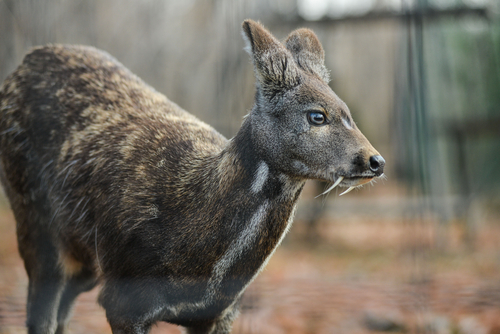
The musk deer, or “vampire deer,” has long fangs, but no antlers.
Otherwise known as musk deer, these “vampires” are actually quite shy and prone to voluntary solitary confinement.
These gentle, nocturnal creatures differ from other cervids, due to their lack of antlers and facial glands. They earned their name through their distinctive sharp vampire-like “fangs.” The over-sized canine teeth are impossible to miss.

Vampire deer skulls are instantly noticeable due to their fanged teeth.
Take note of his over-sized ears, exceptionally short tail, and lack of antlers. Traits like these make the vampire deer one of the easiest kinds to spot. His coat is grayish-brown, and his hair long and brittle.
While their name and long fangs might scare you off, this unique Asian deer is actually harmless. You’ll normally find him in mountainous regions, like the Himalayas or Siberia.







My deer skull has a large bone growth on its head can u tell me about it
Send us a picture. We’d love to take a look!
I live in VA and I was walking my dog, I didn’t notice until she started barking that there was a buck. It was dark, big, big antlers and had a white stomach. I don’t hunt deer or anything like that, I’m just curious as to if you know what kind I’d be talking about.
Stephen, if it was a deer, it would’ve most likely been a whitetail. Most mule deer are found west of the Missouri River.
I live in Long Beach Indiana to a population of about a little over a thousand people over a five square mile area of woods and Sand dunes right on Lake Michigan… We’ve been fighting in our town about to cull or not to cull with bow and arrow hunters😱🦌 there was a vote and it barely passed , that we would not cull the deer but some people are still upset… I tried to explain to them that when I lived in the Ridgefield- Redding area of Connecticut we had a deer problem back in the early ’90s and we solved it by using a birth control method …can you tell me and us more about that
thank you
Donna Kavanagh❤️🦌🙋
To put deer on birth control is not a good idea at all. You can wipe out an entire species by doing that. You are living in the deer territory, not the other way around. I suggest you maybe kill them for their meat (in hunting season), put up better fencing to protect your vegetation, or just move to an area that doesn’t have deer.